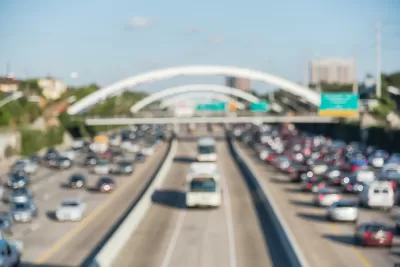The Southern Maryland Rapid Transit Project could take thousands of cars off the road and ease congestion in one of the country's busiest corridors.

With the nation's highest per capita number of road fatalities and the country's costliest commute, Southern Maryland is proposing to alleviate traffic with a light rail project, reports Alex Holt. The 18.7-mile-long Southern Maryland Rapid Transit Project (SMRT) would include 13 stations and give D.C.-area commuters an alternative to personal vehicles.
The state has kicked around the idea since the 1990s without much progress, but as area traffic only gets worse as the population increases, SMRT could pick up more support. This January, state legislators introduced bills proposing to allocate $12 million and $15 million in the 2022 and 2023 budgets for the necessary environmental review that would move the SMRT project forward. Prince George County, which would host eight of the line's stops, has been a staunch supporter of the project, as has the Maryland Transit Caucus.
Governor Larry Hogan, however, has leaned heavily in favor of road projects, writes Alex Holt. Hogan supports doubling the number of lanes on the Harry Nice Bridge, a move that transportation experts say will only increase traffic through the area. SMRT supporters continue to push the project forward. "It's not just about transportation," said Delegate Debra Davis, who introduced one of the January bills. Light rail has the potential to promote economic development and improve public health and quality of life for Maryland residents.
FULL STORY: A proposed light rail for Southern Maryland aims to relieve some of America’s worst traffic

Trump Administration Could Effectively End Housing Voucher Program
Federal officials are eyeing major cuts to the Section 8 program that helps millions of low-income households pay rent.

Planetizen Federal Action Tracker
A weekly monitor of how Trump’s orders and actions are impacting planners and planning in America.

Ken Jennings Launches Transit Web Series
The Jeopardy champ wants you to ride public transit.

Rebuilding Smarter: How LA County Is Guiding Fire-Ravaged Communities Toward Resilience
Los Angeles County is leading a coordinated effort to help fire-impacted communities rebuild with resilience by providing recovery resources, promoting fire-wise design, and aligning reconstruction with broader sustainability and climate goals.

When Borders Blur: Regional Collaboration in Action
As regional challenges outgrow city boundaries, “When Borders Blur” explores how cross-jurisdictional collaboration can drive smarter, more resilient urban planning, sharing real-world lessons from thriving partnerships across North America.

Philadelphia Is Expanding its Network of Roundabouts
Roundabouts are widely shown to decrease traffic speed, reduce congestion, and improve efficiency.
Urban Design for Planners 1: Software Tools
This six-course series explores essential urban design concepts using open source software and equips planners with the tools they need to participate fully in the urban design process.
Planning for Universal Design
Learn the tools for implementing Universal Design in planning regulations.
Ada County Highway District
Clanton & Associates, Inc.
Jessamine County Fiscal Court
Institute for Housing and Urban Development Studies (IHS)
City of Grandview
Harvard GSD Executive Education
Toledo-Lucas County Plan Commissions
Salt Lake City
NYU Wagner Graduate School of Public Service





























